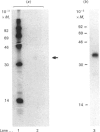Abstract
An arabinogalactan-protein (AGP) purified from the filtrate of liquid-suspension-cultured Italian-ryegrass (Lolium multiflorum) endosperm cells by affinity chromatography on myeloma protein J539-Sepharose was deglycosylated with trifluoromethanesulphonic acid to remove polysaccharide chains that are covalently associated with hydroxyproline residues in the peptide component of the proteoglycan. The protein core, which accounts for less than 10% (w/w) of the intact proteoglycan, was purified by h.p.l.c. It has an apparent Mr of 35,000, but reacts very poorly with both Coomassie Brilliant Blue R and silver stains. Amino-acid-sequence analysis of the N-terminus of the h.p.l.c.-purified protein core and of tryptic peptides generated from the unpurified protein reveals a high content of hydroxyproline and alanine. These are sometimes arranged in short (Ala-Hyp) repeat sequences of up to six residues. Polyclonal antibodies raised against the protein core do not cross-react with native AGP, the synthetic peptide (Ala-Hyp)4, poly-L-hydroxyproline or poly-L-proline. The results suggest that the polysaccharide chains in the native AGP render the protein core of the proteoglycan inaccessible to the antibodies and that the immunodominant epitopes include domains of the protein other than those rich in Ala-Hyp repeating units.
Full text
PDF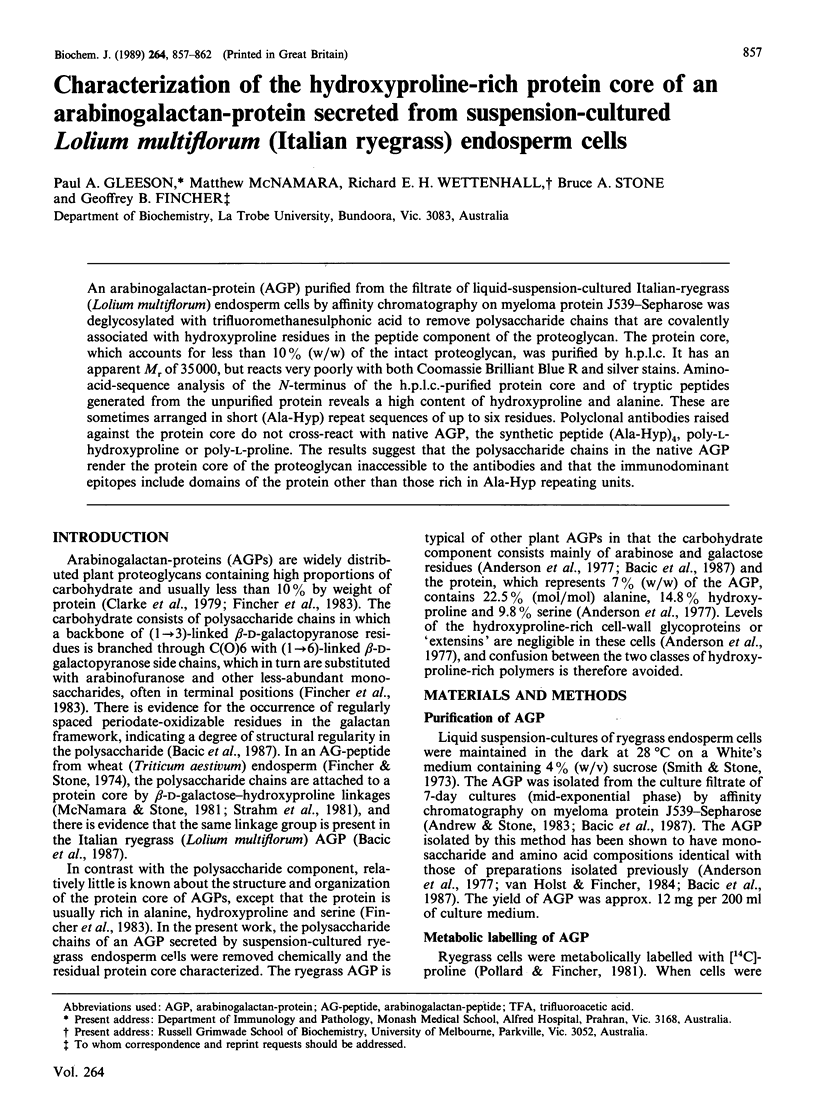
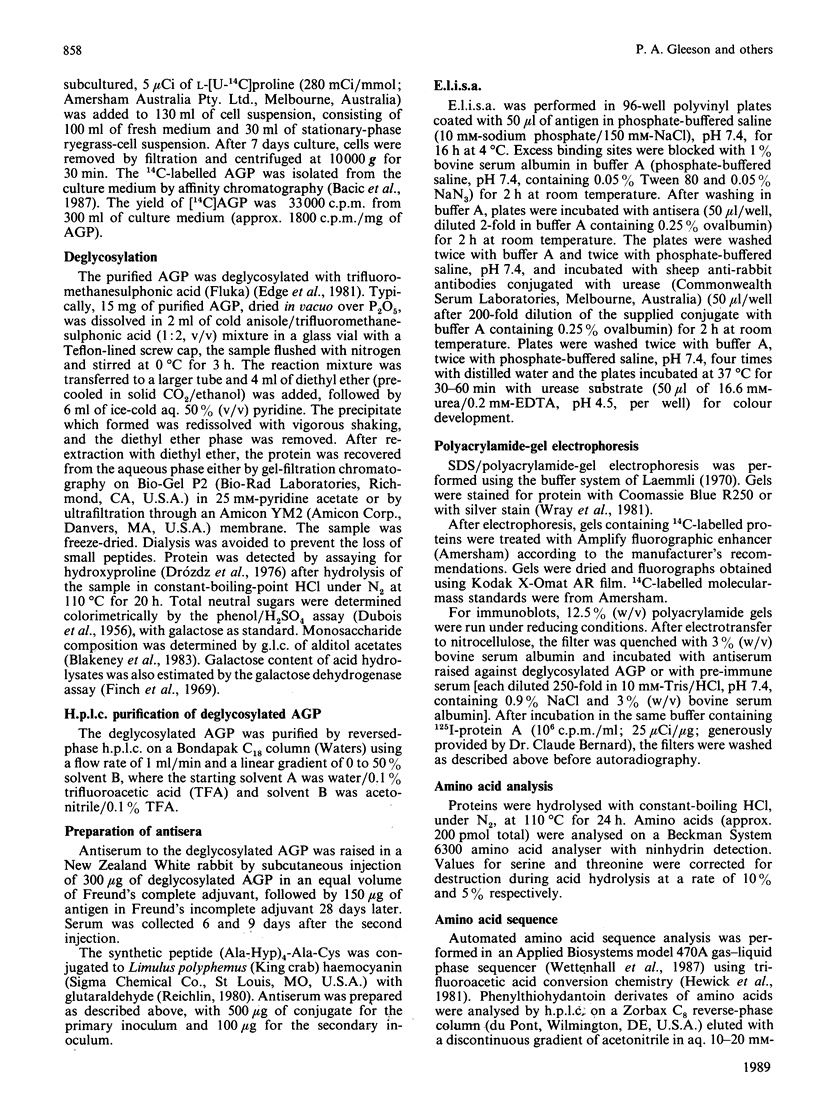
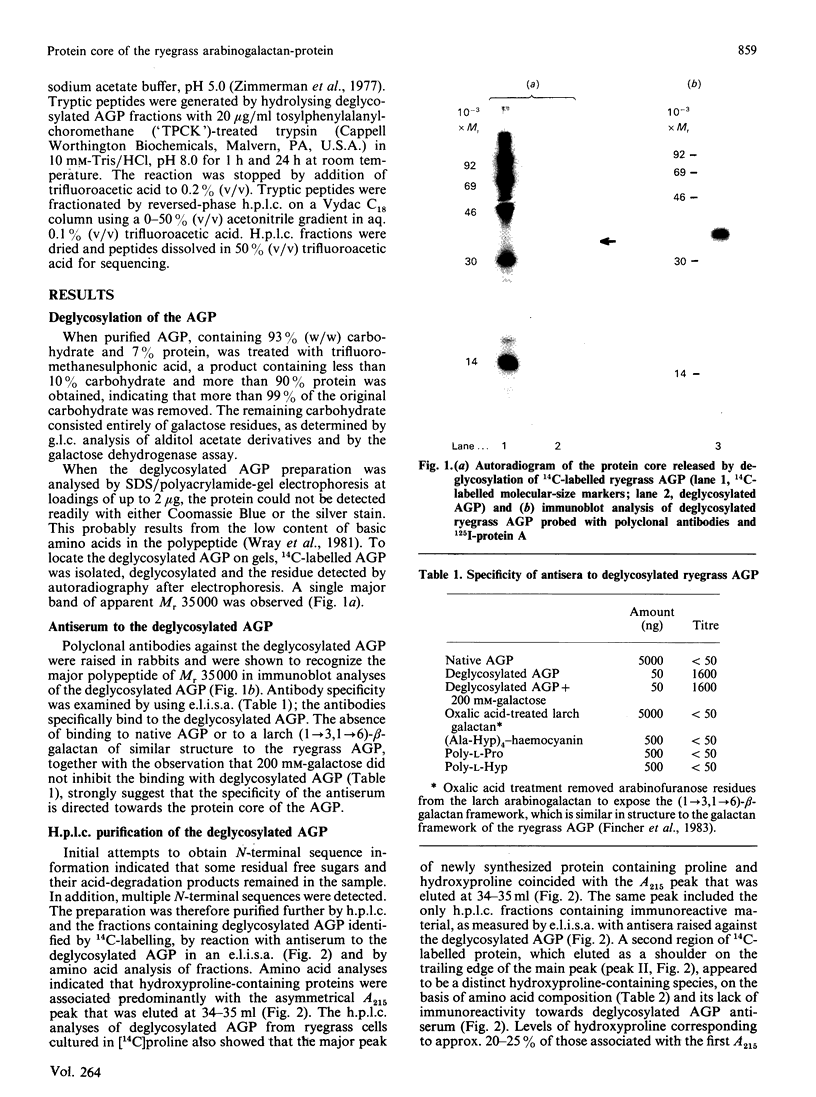
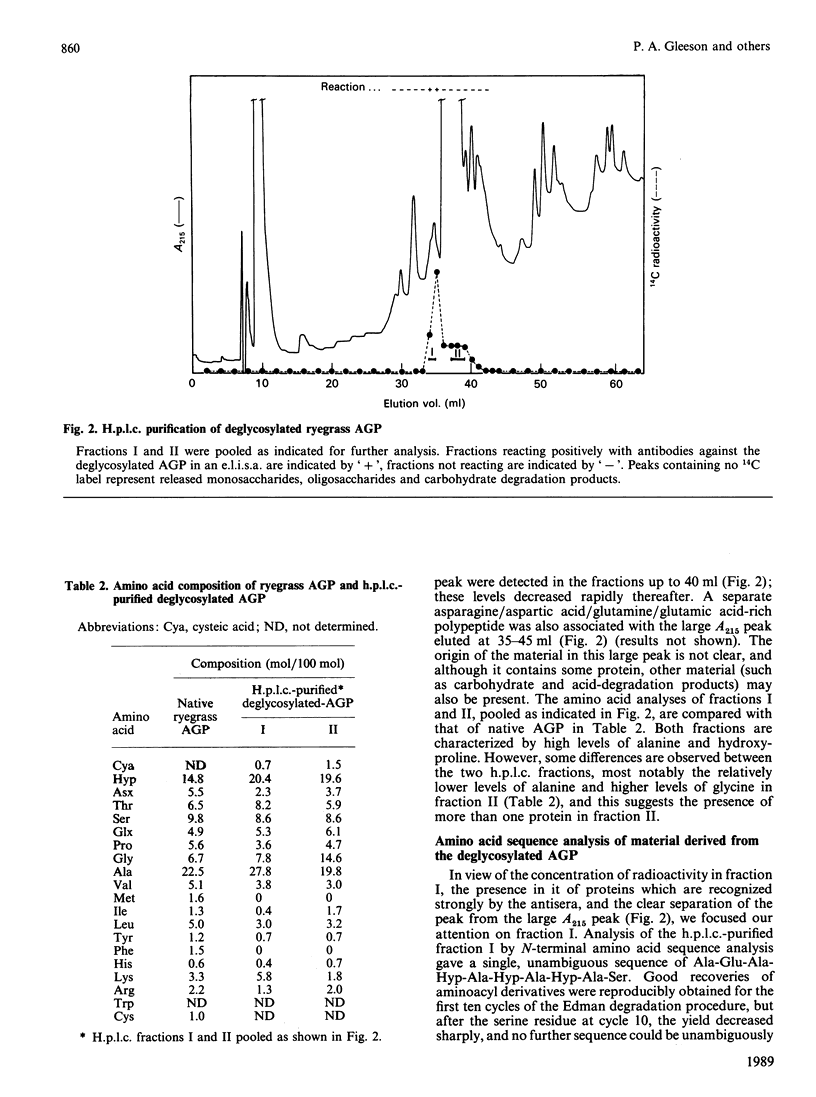
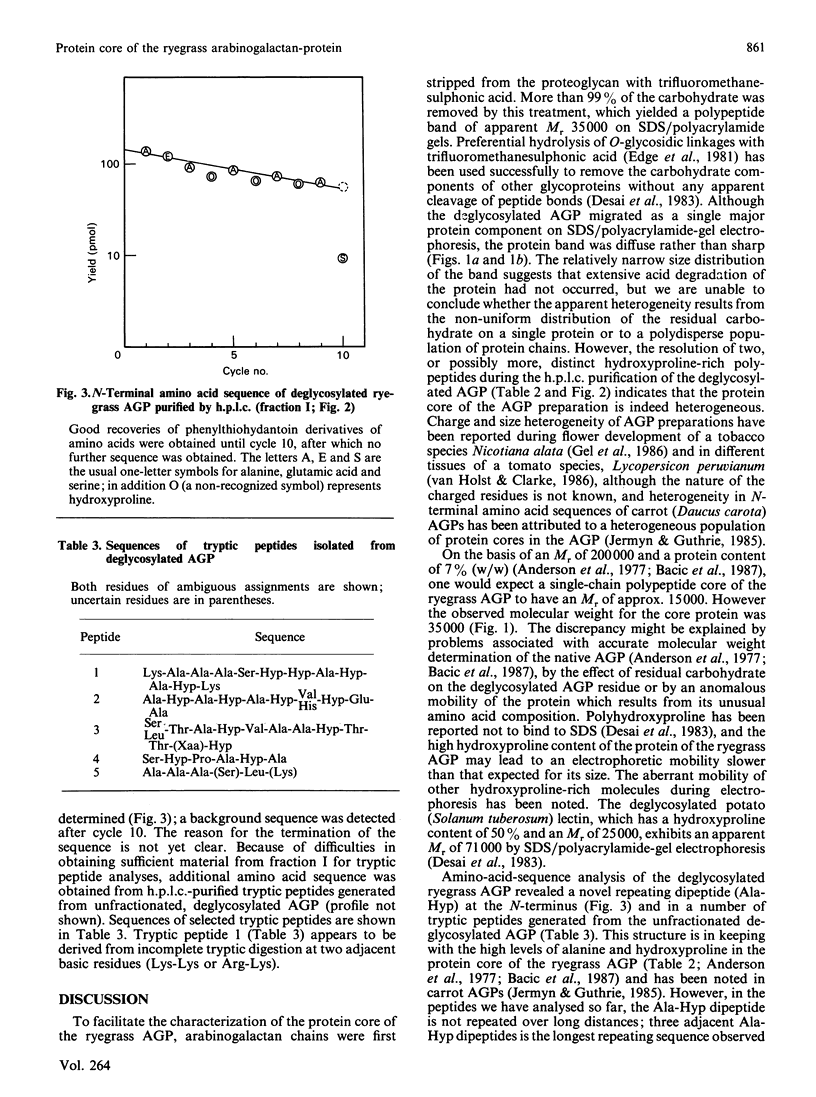
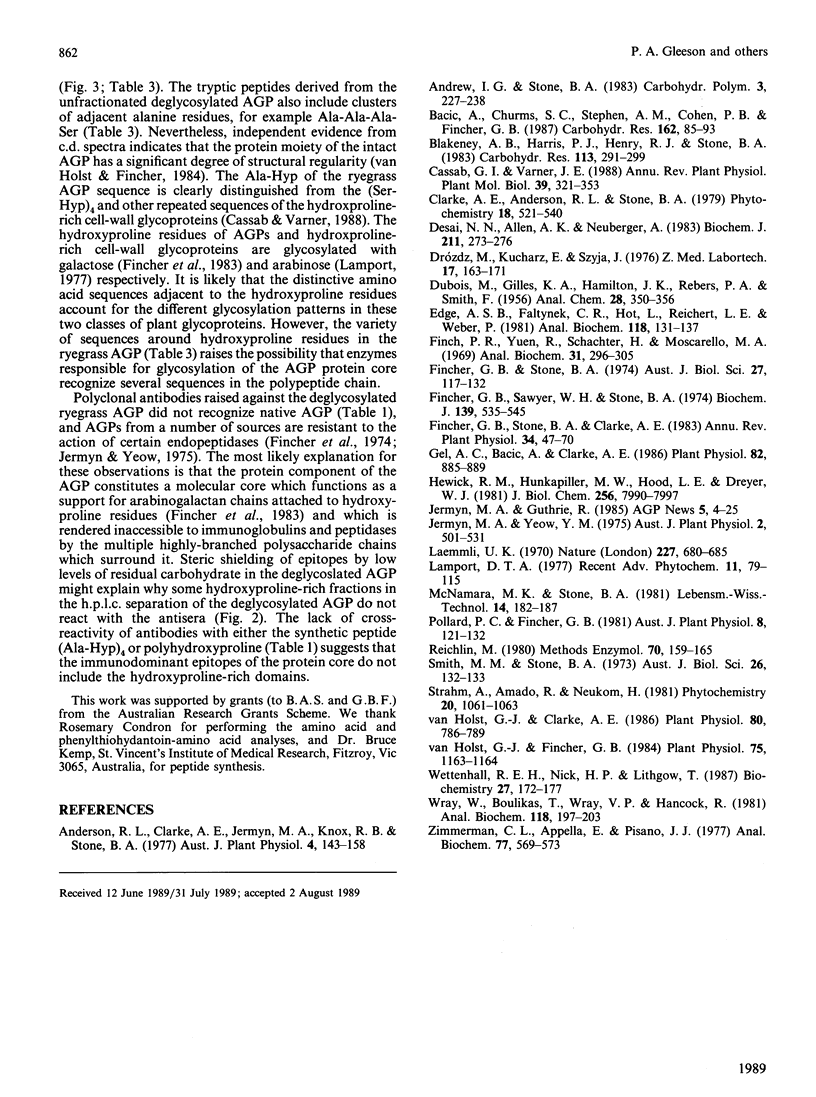
Images in this article
Selected References
These references are in PubMed. This may not be the complete list of references from this article.
- Desai N. N., Allen A. K., Neuberger A. The properties of potato (Solanum tuberosum) lectin after deglycosylation by trifluoromethanesulphonic acid. Biochem J. 1983 Apr 1;211(1):273–276. doi: 10.1042/bj2110273. [DOI] [PMC free article] [PubMed] [Google Scholar]
- Drózdz M., Kucharz E., Szyja J. A colorimetric micromethod for determination of hydroxyproline in blood serum. Z Med Labortech. 1976 Aug 4;17(4):163–171. [PubMed] [Google Scholar]
- Edge A. S., Faltynek C. R., Hof L., Reichert L. E., Jr, Weber P. Deglycosylation of glycoproteins by trifluoromethanesulfonic acid. Anal Biochem. 1981 Nov 15;118(1):131–137. doi: 10.1016/0003-2697(81)90168-8. [DOI] [PubMed] [Google Scholar]
- Fincher G. B., Sawyer W. H., Stone B. A. Chemical and physical properties of an arabinogalactan-peptide from wheat endosperm. Biochem J. 1974 Jun;139(3):535–545. doi: 10.1042/bj1390535. [DOI] [PMC free article] [PubMed] [Google Scholar]
- Gell A. C., Bacic A., Clarke A. E. Arabinogalactan-Proteins of the Female Sexual Tissue of Nicotiana alata: I. Changes during Flower Development and Pollination. Plant Physiol. 1986 Dec;82(4):885–889. doi: 10.1104/pp.82.4.885. [DOI] [PMC free article] [PubMed] [Google Scholar]
- Hewick R. M., Hunkapiller M. W., Hood L. E., Dreyer W. J. A gas-liquid solid phase peptide and protein sequenator. J Biol Chem. 1981 Aug 10;256(15):7990–7997. [PubMed] [Google Scholar]
- Laemmli U. K. Cleavage of structural proteins during the assembly of the head of bacteriophage T4. Nature. 1970 Aug 15;227(5259):680–685. doi: 10.1038/227680a0. [DOI] [PubMed] [Google Scholar]
- Reichlin M. Use of glutaraldehyde as a coupling agent for proteins and peptides. Methods Enzymol. 1980;70(A):159–165. doi: 10.1016/s0076-6879(80)70047-2. [DOI] [PubMed] [Google Scholar]
- Wettenhall R. E., Nick H. P., Lithgow T. Primary structure of mammalian ribosomal protein S6. Biochemistry. 1988 Jan 12;27(1):170–177. doi: 10.1021/bi00401a026. [DOI] [PubMed] [Google Scholar]
- Wray W., Boulikas T., Wray V. P., Hancock R. Silver staining of proteins in polyacrylamide gels. Anal Biochem. 1981 Nov 15;118(1):197–203. doi: 10.1016/0003-2697(81)90179-2. [DOI] [PubMed] [Google Scholar]
- Zimmerman C. L., Appella E., Pisano J. J. Rapid analysis of amino acid phenylthiohydantoins by high-performance liquid chromatography. Anal Biochem. 1977 Feb;77(2):569–573. doi: 10.1016/0003-2697(77)90276-7. [DOI] [PubMed] [Google Scholar]
- van Holst G. J., Clarke A. E. Organ-Specific Arabinogalactan-Proteins of Lycopersicon peruvianum (Mill) Demonstrated by Crossed Electrophoresis. Plant Physiol. 1986 Mar;80(3):786–789. doi: 10.1104/pp.80.3.786. [DOI] [PMC free article] [PubMed] [Google Scholar]
- van Holst G. J., Fincher G. B. Polyproline II Confirmation in the Protein Component of Arabinogalactan-Protein from Lolium multiflorum. Plant Physiol. 1984 Aug;75(4):1163–1164. doi: 10.1104/pp.75.4.1163. [DOI] [PMC free article] [PubMed] [Google Scholar]



